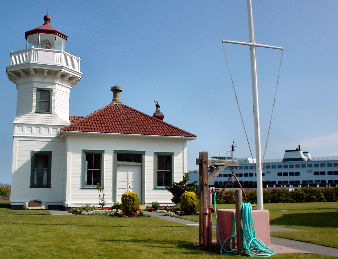 I'm writing from one of my favorite spots in the world, the ferry landing at Mukilteo, WA. The ferry to Whidbey Island docks adjacent to the Mukilteo lighthouse, one of the best-looking and most easily-accessible lighthouses in the world. You can walk to the top for a close-up view of its really-cool lens. The famous Ivar's Mukilteo Landing Restaurant on the opposite side of the ferry entrance has been there for decades, with a walk-up window to serve clams and fish and chips to people waiting for the ferry.
I'm writing from one of my favorite spots in the world, the ferry landing at Mukilteo, WA. The ferry to Whidbey Island docks adjacent to the Mukilteo lighthouse, one of the best-looking and most easily-accessible lighthouses in the world. You can walk to the top for a close-up view of its really-cool lens. The famous Ivar's Mukilteo Landing Restaurant on the opposite side of the ferry entrance has been there for decades, with a walk-up window to serve clams and fish and chips to people waiting for the ferry.A cup of cappuccino would make my morning perfect. You can normally get a nice cappuccino within short walking distance of any given point in the Seattle metropolitan area, and this place is no exception. I walk over to Woody's, an establishment across the street from the lighthouse. It looks more like a bait shop than a coffee shop, but the cappuccino is first-class. The foam is at least two inches think, with a sprinkling of cinnamon on top.
You say "Cappuccino";
I say "Capuchini"
Thinking about cappuccino reminds me of another of my favorite places in the world. It's the most macabre and fascinating tourist attraction I have ever seen: the Capuchini Catacombs in Palermo, Italy.
 Cappuccino, you may know, is so named because its color matches the trademark hooded garment of a Capuchin monk. The Capuchins are an order of Franciscans founded about the same time the Protestant Reformation began in the early sixteenth century. The Capuchini recognized the need for reform in the church, but instead of doctrinal reform, they favored an approach that called for a return to the strict austerity of the original Franciscans. They were a monkish version of the strictest kind of fundamentalists. They went barefoot, lived in extreme poverty, and adopted a famous hooded habit like the one worn by St. Francis. (The garment, known as a capucize, was so much the emblem of the order that their name was derived from it. Padre Pio, famous mystic and stigmatist, now a saint, was a Capuchin.)
Cappuccino, you may know, is so named because its color matches the trademark hooded garment of a Capuchin monk. The Capuchins are an order of Franciscans founded about the same time the Protestant Reformation began in the early sixteenth century. The Capuchini recognized the need for reform in the church, but instead of doctrinal reform, they favored an approach that called for a return to the strict austerity of the original Franciscans. They were a monkish version of the strictest kind of fundamentalists. They went barefoot, lived in extreme poverty, and adopted a famous hooded habit like the one worn by St. Francis. (The garment, known as a capucize, was so much the emblem of the order that their name was derived from it. Padre Pio, famous mystic and stigmatist, now a saint, was a Capuchin.)The early sect was much persecuted, even by other Franciscan friars. The pope made a rule confining the Capuchin order to Italy. One of the Capuchini's two founders soon left, and the other was expelled for insubordination. The third Capuchin vicar-general, Bernardino Ochino, was supposedly converted to Protestantism and became a Calvinist. The pope responded to that "setback" by forbidding all Capuchins to preach. (Ochino later flirted with Socinian ideas and was expelled from Zurich.)
Meanwhile, however, as the Roman Catholic Counter-Reformation gained influence and the truth about worldliness and corruption in the Roman system was exposed even from within, reform movements like the Capuchini became increasingly popular. Within a decade after the Council of Trent, Italy boasted some 17,000 Capuchin monks.
By the beginning of the sixteenth century, leading elements in the Capuchin order seem to have acquired a macabre fascination with death—human remains in particular. The Capuchin brothers specialized in various kinds of "burial art"—making decorations from human bones, and preserving the dead for display.
My first personal encounter with Capuchini deathcraft was in Rome, about a decade ago. The Capuchini have decorated the crypt of the church of Santa Maria della Concezione on Via Vittorio Veneto street (near Piazza Barberini) with thousands of human bones. The Marquis de Sade visited there and wrote of the place in 1775. It was just his cup of tea.
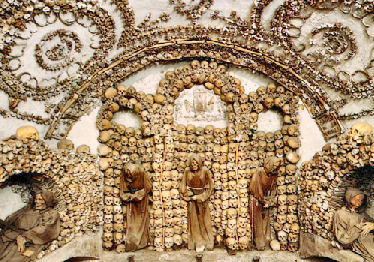
So a few years later, while teaching at a conference in Sicily, a small group of us were traveling near Palermo (under the guidance and hospitality of our dear friends Joe and Georgia Aleppo). Another good friend and fellow pastor, Carey Hardy, pointed out an ad in one of those local-attraction magazines for tourists. The ad featured a gruesome picture of a rotted corpse, and promised thousands of similar mummified cadavers on display at the Capuchin Crypt in Palermo.
Naturally, Carey and I both wanted to go there without delay.
Our wives were less enthusiastic, of course, but we prevailed. It turned out to be well worth the trip. There are literally hundreds if not thousands of ancient corpses in the crypt, dating back to the early 1600s, all in various states of decay, and most dressed in their finest clothing. They are on display right in the open, not behind any glass or bars.
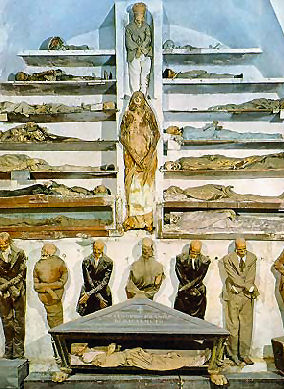 Apparently, the crypt's collection began in 1599, when the Capuchini preserved one of their own so that they could actually see him while they prayed to him. The properties of dry air and temperature in the crypt turned out to be perfect for drying and preserving corpses, and the friars perfected methods of preservation that produced better and better results all the time. Wealthy citizens of Palermo all wanted to be preserved there, so that relatives could always visit. Thus the crypt holds many wealthy and important figures, including Giovanni Paterniti, American Vice Consul, who died in 1911.
Apparently, the crypt's collection began in 1599, when the Capuchini preserved one of their own so that they could actually see him while they prayed to him. The properties of dry air and temperature in the crypt turned out to be perfect for drying and preserving corpses, and the friars perfected methods of preservation that produced better and better results all the time. Wealthy citizens of Palermo all wanted to be preserved there, so that relatives could always visit. Thus the crypt holds many wealthy and important figures, including Giovanni Paterniti, American Vice Consul, who died in 1911.Some of the remains are mere skeletons, but many others, apart from being shrivelled and creepy and looking very much like discarded props from horror movies, are amazingly well preserved, with every pore in the skin still visible and almost every hair still intact. In some cases, the corpse's clothing is more decayed than the carcass itself. The clothing alone is a fascinating study in the evolution of styles.
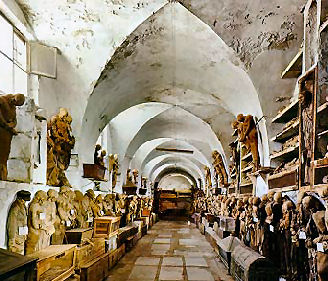
One famous mummy is the perfectly-preserved body of Rosalia Lombardo, a child who died about 1920 and was one of the last corpses added to the collection before city officials prohibited any more. She is preserved with perfect lifelikeness and color.
Darlene did not enjoy the Capuchin crypt. I was so fascinated by the authentic 400-year-old clothing and the sketchy life stories of the corpses that I could have spent hours there. It remains my top recommendation for the most interesting tourist attraction I have ever seen, and a graphic reminder of the truth of Isaiah 40:6-8: "All flesh is grass, and all the goodliness thereof is as the flower of the field . . . The grass withereth, the flower fadeth: but the word of our God shall stand for ever."
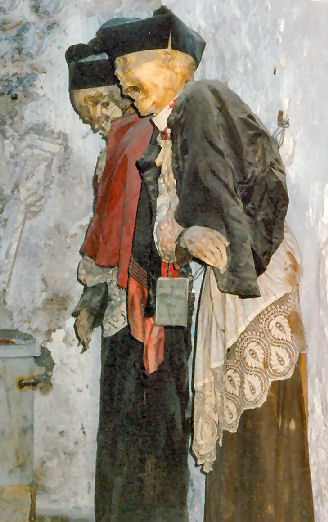
Now I'm ready for clams at Ivar's. See you when I get home.

11 comments:
I will be making plans forthwith! Forget about all that ancient art and sculpture stuff.
Fred
Fred's Bible Talk
that was...uhhh...interesting Phil.
I might make a blog entry about your blog entry.
Nice set up for it....and nice non-warning about what was coming.
LOL
Kerry
One mans "eww" is another mans art, I guess.
Signed,
Eww
(loved the shot at the top - brings back memories of growing up in western WA - but "eww" on the clams)
Thanks for the post. I was experiencing withdrawals.
Kelly wants to know if it smelled in there Sick!!
I was onced defecated on by a seagull while uloading a boat at the dock right next to that lighthouse. Ivars is good. You should try Arnie's next time.
Anyway, I was directed towards this site by my good buddy Mark O. who says we look exactly alike. I don't know what that has to do with anything, really.
I've used the daily Spurgeon devotional quite a bit. Nice to see you joined the 'sphere.
Cheers!
This is a highly fascinating post, thank you! Your blog is brand new to me and I will be returning. It is nice to find a theologically-minded man with a sense of humor too.
Warmly,
Kate
I don't feel so much "Ewww" as Carla does (I once dissected a human cadaver...it takes a lot to trigger my Ewww respose), but I wonder whether the proper Christian response to this sort of thing is (literally) morbid curiosity. Shouldn't this rather more offend than attract us? I can't think that a neutral, dispassionate anthropological interest is quite right. These death displays ought to be denounced as a perverse, anti-Gospel glorification of a great enemy. Death is a defeated enemy, to be sure, but still an enemy. And being quite comfortable with this sort of thing smacks a bit of carelessly treasonous fraternization.
I hope you will pardon me for fussing at you in my first comment here. But since I've already started, here's another, more lighthearted criticism: Your comments are rather unhelpfully set to show only the time of each comment. If, like me, you think it would be nicer to show the date, as well, go into Blogger and click Settings > Comments; scroll down to "Comments Timestamp Format" and select a more informative option.
Cordially (really!),
~Valerie
Valerie wrote: "I wonder whether the proper Christian response to this sort of thing is (literally) morbid curiosity. Shouldn't this rather more offend than attract us? I can't think that a neutral, dispassionate anthropological interest is quite right. These death displays ought to be denounced as a perverse, anti-Gospel glorification of a great enemy."
Good points. I'm both offended AND intrigued by displays like this. I briefly contemplated going to see the plasticized-cadavers display now touring the country when it was in LA, but ultimately decided not to. Having once worked in a mortuary, I'm not automatically repulsed by a corpse, but I'm uneasy with the deliberate glorification of death—and I'm certainly concerned for anyone for whom death is an obsession.
On the other hand, it's not the display of a corpse per se that disturbs me. I think the mummy display in the British Museum is facinating and legitimate. I disagree with those who oppose all anthropological investigations into Native American culture because they think the bones of ancient ancestors must never be disturbed. After the passage of so much time, legitimate historical and anthropological interests must be weighed alongside the "morbid curiosity" factor.
The Capuchin crypt at Palermo certainly blurs the line between the two. If I had been able to talk to the Monks in 1599 about the validity of this approach to death, I would have argued strongly aganst the preservation and public display of cadavers. But now that they have been there for generations, they are really interesting to see. I don't really know what it is about the passage of time that makes it seem different, but it does to me.
King Tut might have a different opinion, if he knew his corpse and the artifacts associated with his death would be going on permanent tour 2,000 years after he was laid to rest. The whole subject raises some difficult and troubling questions.
Anyway, I fixed the time stamps for you. Thanks for the suggestions.
Thanks for clarifying where you're coming from. I guess my tendency would be to stay a little farther away from the blurry line, and this case particularly disturbed me because this was done by people who claimed to be Christians. I thought about Tut, too, and wondered if I tend to let time and distance inform my sensibilities too much: Tut's really, really old, so it seems more OK to gawk at his remains, whereas there are people still living who older than Rosalia Lombardo would have been had she lived, so it's more macabre to gawk at hers.
I probably wouldn't go to see the plasticized cadavers, either, but I let myself look at pictures of them online, then wondered if I should have. It certainly bothered me greatly when one was stolen -- far more than the theft of a typical museum object would have bothered me. What does that tell me?
Anyway, I've wandered into attempting to discern right and wrong based on emotional responses, which probably isn't a safe or wise place to be, so I'll shut up, now.
Thanks for changing the time stamp. Isn't that better? :-)
Wow. Who would have guessed that one of the famous Phil Johnson's favorite spots in the world also happened to be mine as well?
Mukilteo Beach. Ah the memories. I lost a kite in the powerlines once...I cried.
In 2nd grade we found a stray dog roaming the beach. We took him home and named him Blackie. What color do you think he was?
My family has celebrated many a birthday at Ivar's.
I've walked hand-in-hand with my beautiful wife in that park.
Memories...
Maybe my next one will involve the Pyro?
See you at the ferry!
Post a Comment